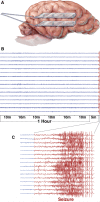Crowdsourcing reproducible seizure forecasting in human and canine epilepsy
- PMID: 27034258
- PMCID: PMC5022671
- DOI: 10.1093/brain/aww045
Crowdsourcing reproducible seizure forecasting in human and canine epilepsy
Abstract
SEE MORMANN AND ANDRZEJAK DOI101093/BRAIN/AWW091 FOR A SCIENTIFIC COMMENTARY ON THIS ARTICLE : Accurate forecasting of epileptic seizures has the potential to transform clinical epilepsy care. However, progress toward reliable seizure forecasting has been hampered by lack of open access to long duration recordings with an adequate number of seizures for investigators to rigorously compare algorithms and results. A seizure forecasting competition was conducted on kaggle.com using open access chronic ambulatory intracranial electroencephalography from five canines with naturally occurring epilepsy and two humans undergoing prolonged wide bandwidth intracranial electroencephalographic monitoring. Data were provided to participants as 10-min interictal and preictal clips, with approximately half of the 60 GB data bundle labelled (interictal/preictal) for algorithm training and half unlabelled for evaluation. The contestants developed custom algorithms and uploaded their classifications (interictal/preictal) for the unknown testing data, and a randomly selected 40% of data segments were scored and results broadcasted on a public leader board. The contest ran from August to November 2014, and 654 participants submitted 17 856 classifications of the unlabelled test data. The top performing entry scored 0.84 area under the classification curve. Following the contest, additional held-out unlabelled data clips were provided to the top 10 participants and they submitted classifications for the new unseen data. The resulting area under the classification curves were well above chance forecasting, but did show a mean 6.54 ± 2.45% (min, max: 0.30, 20.2) decline in performance. The kaggle.com model using open access data and algorithms generated reproducible research that advanced seizure forecasting. The overall performance from multiple contestants on unseen data was better than a random predictor, and demonstrates the feasibility of seizure forecasting in canine and human epilepsy.media-1vid110.1093/brain/aww045_video_abstractaww045_video_abstract.
Keywords: epilepsy; experimental models; intracranial EEG; refractory epilepsy.
© The Author (2016). Published by Oxford University Press on behalf of the Guarantors of Brain.
Figures




Comment in
-
Seizure prediction: making mileage on the long and winding road.Brain. 2016 Jun;139(Pt 6):1625-7. doi: 10.1093/brain/aww091. Brain. 2016. PMID: 27234060 No abstract available.
References
-
- Aarabi A, Wallois F, Grebe R. Does spatiotemporal synchronization of EEG change prior to absence seizures? Brain Res 2008; 1188: 207–21. - PubMed
-
- Adelson PD, Nemoto E, Scheuer M, Painter M, Morgan J, Yonas H. Noninvasive continuous monitoring of cerebral oxygenation periictally using near-infrared spectroscopy: a preliminary report. Epilepsia 1999; 40: 1484–9. - PubMed
-
- Andrzejak RG, Chicharro D, Elger CE, Mormann F. Seizure prediction: any better than chance? Clin Neurophysiol 2009; 120: 1465–78. - PubMed
-
- Badawy R, Macdonell R, Jackson G, Berkovic S. The peri-ictal state: cortical excitability changes within 24 h of a seizure. Brain 2009; 132: 1013–21. - PubMed
-
- Baumgartner C, Serles W, Leutmezer F, Pataraia E, Aull S, Czech T, et al. Preictal SPECT in temporal lobe epilepsy: regional cerebral blood flow is increased prior to electroencephalography-seizure onset. J Nucl Med 1998; 39: 978–82. - PubMed
Publication types
MeSH terms
Grants and funding
LinkOut - more resources
Full Text Sources
Other Literature Sources
Medical
Miscellaneous

